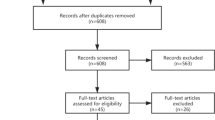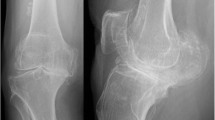Abstract
Purpose
The optimal degree of constraint of a total knee arthroplasty for treatment of knee osteoarthritis with ligamentous laxity is under debate. While varus valgus constrained knees require a minimum level of ligamentous stability, rotating hinge knees can even be implanted if the collateral ligaments have been lost completely. It seems plausible that joint kinematics are determined by implant design in rotating hinge knees, whereas varus valgus constrained knees may be influenced by remaining stabilizers. This may result in more predictable clinical results of hinge knees. The hypothesis of the present study, therefore, was that stability and clinical outcome are better after total knee arthroplasty using rotating hinge knees than after using varus valgus constrained knees.
Methods
All patients who were treated using a mobile-bearing varus valgus constrained knee or a rotating hinge knee for treatment of end-stage osteoarthritis and ligamentous laxity were included. At follow-up, clinical scores were determined (WOMAC, VAS, KSS, FJS, Lysholm). Furthermore, body mass index, operating time, and postoperative complications were documented. Whole leg radiographs as well as patella axial radiographs were analyzed for implant alignment and patella tracking.
Results
Eighty-five patients were included in this retrospective study. Both groups showed an average range of motion of 113°. No significant difference between the two groups was observed for any of the scores recorded. In the rotating hinge knee group, a more precise tibia positioning in relation to the mechanical axis but also a significant lateralisation and tilting of the patella were seen, compared with the varus valgus constrained knee group.
Conclusions
Rotating hinge knees did not perform better than mobile-bearing varus valgus constrained knees clinically. Both prosthesis types showed equally good clinical outcomes with regard to stability, mobility, satisfaction, pain and operating time.
Level of evidence
Retrospective case series, Level IV.

Similar content being viewed by others
References
American Joint Replacement Registry (AJRR) Annual Report 2018 (http://www.ajrr.net)
Arthroplasty Register Germany (EPRD) Annual Report 2017 (http://www.eprd.de)
Baker P, Critchley R, Gray A, Jameson S, Gregg P, Port A, Deehan D (2014) Mid-term survival following primary hinged total knee replacement is good irrespective of the indication for surgery. Knee Surg Sports Traumatol Arthrosc 22(3):599–608
Bistolfi A, Lustig S, Rosso F, Daimasso P, Crova M, Massazza G (2013) Results With 98 Endo-modell rotating hinge prostheses for primary knee arthroplasty. Orthopedics 36(6):e746–e752
Böhm P, Holy T (1998) Is there a future for hinged prostheses in primary total knee arthroplasty? A 20-year survivorship analysis of the Blauth prosthesis. J Bone Joint Surg Br 80(2):302–309
Feng XB, Yang C, Fu DH, Ye SN, Liu XZ, Chen Z, Rai S, Yang SH (2016) Mid-term outcomes of primary constrained condylar knee arthroplasty for severe knee deformity. J Huazhong Univ Sci Technolog Med Sci 36(2):231–236
Gehrke T, Kendoff D, Haasper C (2014) The role of hinges in primary total knee replacement. Bone Joint J 96-B(11 Supple A):93–95
Guenoun B, Latargez L, Freslon M, Defossez G, Salas N, Gayet LE (2009) Complications following rotating hinge Endo-Modell (Link) knee arthroplasty. Orthop Traumatol Surg Res 95(7):529–536
Helito CP, Giglio PN, Cavalheiro CM, Gobbi RG, Demange MK, Camanho GL (2018) Knee arthroplasty with rotating-hinge implant: an option for complex primary cases and revisions. Rev Bras Ortop 53(2):151–157
Hernandez-Vaquero D, Sandoval-Garc ́ıa MA (2010) Hinged total knee arthroplasty in the presence of ligamentous deficiency. Clin Orthop Relat Res 468(5):1248–1253
Lachiewicz PF, Soileau ES (2006) Ten-year survival and clinical results of constrained components in primary total knee arthroplasty. J Arthroplasty 21(6):803–808
Lombardi AV, Berend KR, Adams JB (2014) Why knee replacements fail in 2013: patient, surgeon, or implant? Bone Joint J 96-B(11 Supple A):101–104
Lombardi AV, Berend KR, Leith JR, Mangino GP, Adams JB (2007) Posterior-stabilized constrained total knee arthroplasty for complex primary cases. J Bone Joint Surg Am 89(Suppl 3):90–102
Long R, Gheduzzi S, Bucher TA, Toms AD, Miles AW (2013) A biomechanical evaluation of hinged total knee replacement prostheses. Proc Inst Mech Eng H 227(8):875–883
Malcolm TL, Bederman SS, Schwarzkopf R (2016) Outcomes of varus valgus constrained versus rotating-hinge implants in total knee arthroplasty. Orthopedics 39(1):e140–e148
Martin JR, Beahrs TR, Stuhlman CR, Trousdale RT (2016) Complex primary total knee arthroplasty: long-term outcomes. J Bone Joint Surg Am 98(17):1459–1470
Mavrodontidis AN, Andrikoula SI, Kontogeorgakos VA et al (2008) Application of the endomodel rotating hinge knee prosthesis for knee osteoarthritis. J Surg Orthop Adv 17:179–184
Morgan H, Battista V, Leopold SS (2005) Constraint in primary total knee arthroplasty. J Am Acad Orthop Surg 13(8):515–524
Naudie DD, Rorabeck CH (2004) Managing instability in total knee arthroplasty with constrained and linked implants. Instr Course Lect 53:207–215
Panni AS, Ascione F, Rossini M, Braile A, Corona K, Vasso M, Hirschmann MT (2018) Tibial internal rotation negatively affects clinical outcomes in total knee arthroplasty: a systematic review. Knee Surg Sports Traumatol Arthrosc 26(6):1636–1644
Petrou G, Petrou H, Tilkeridis C et al (2004) Medium-term results with a primary cemented rotating-hinge total knee replacement: a 7- to 15-year follow-up. J Bone Joint Surg [Br] 86-B:813–817
Sabatini L, Risitano S, Rissolio L, Bonani A, Atzori F, Massè A (2017) Condylar constrained system in primary total knee replacement: our experience and literature review. Ann Transl Med 5(6):135
Sharkey PF, Hozack WJ, Rothman RH, Shastri S, Jacoby SM (2002) Insall Award paper. why are total knee arthroplasties failing today? Clin Orthop Relat Res 404:7–13
Springer BD, Hanssen AD, Sim FH, Lewallen DG (2001) The kinematic rotating hinge prosthesis for complex knee arthroplasty. Clin Orthop Relat Res 392:283–291
Swedish Knee Arthroplasty Register Annual Report 2018
Thiele K, Perka C, Matziolis G, Mayr HO, Sostheim M, Hube R. Current failure mechanisms after knee arthroplasty have changed: polyethylene wear is less common in revision surgery. J Bone Joint Surg Am 97(9):715–720
Yang JH, Yoon JR, Oh CH, Kim TS (2012) Primary total knee arthroplasty using rotating-hinge prosthesis in severely affected knees. Knee Surg Sports Traumatol Arthrosc 20:517–523
Funding
No external funding was used for this study.
Author information
Authors and Affiliations
Corresponding author
Ethics declarations
Conflict of interest
The authors declare that they have no conflict of interest.
Ethical approval
The study had the approval of the local ethics committee of the Friedrich-Schiller University, University Hospital Jena (4632-12/15).
Rights and permissions
About this article
Cite this article
Röhner, E., Benad, K., Zippelius, T. et al. Good clinical and radiological results of total knee arthroplasty using varus valgus constrained or rotating hinge implants in ligamentous laxity. Knee Surg Sports Traumatol Arthrosc 27, 1665–1670 (2019). https://doi.org/10.1007/s00167-018-5307-6
Received:
Accepted:
Published:
Issue Date:
DOI: https://doi.org/10.1007/s00167-018-5307-6




